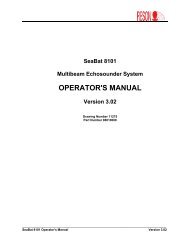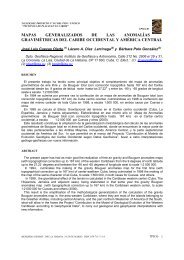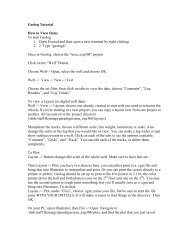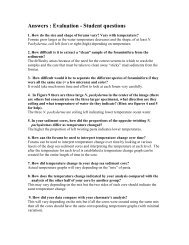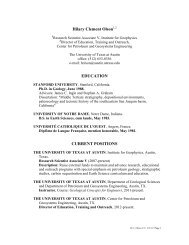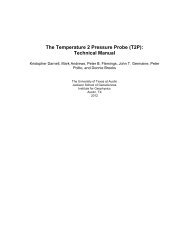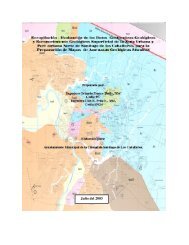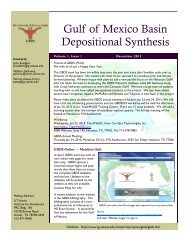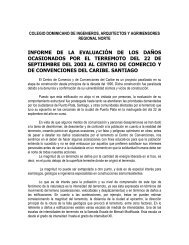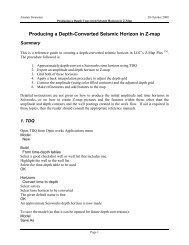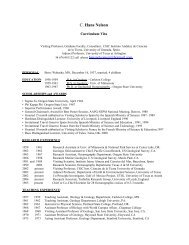IGCP Project short title: Caribbean Plate Tectonics Duration and ...
IGCP Project short title: Caribbean Plate Tectonics Duration and ...
IGCP Project short title: Caribbean Plate Tectonics Duration and ...
You also want an ePaper? Increase the reach of your titles
YUMPU automatically turns print PDFs into web optimized ePapers that Google loves.
28<br />
covering the oceanic crust southwest of the GSPRFZ may have been offscraped <strong>and</strong><br />
deformed as they were carried toward the trench. Subduction related Eocene volcanism was<br />
areally limited <strong>and</strong> <strong>short</strong>-lived. Convergence waned during Oligocene time perhaps in<br />
response to the arrival <strong>and</strong> collision of thick oceanic terrains (eg. Cayman Ridge, Nicaraguan<br />
Rise, Beata Ridge) with the overriding plate. During collision, volcanic units at the edge of<br />
the overriding crust were uplifted <strong>and</strong> destabilized sufficiently so that masses calved off <strong>and</strong><br />
collapsed southwestward forming an apron of debris (Sabana Gr<strong>and</strong>e Formation). We<br />
propose that the Eocene volcanic rocks record renewed subduction, although the subduction<br />
was north-facing <strong>and</strong> involved the consumption of the <strong>Caribbean</strong> plate along a zone roughly<br />
coincident with the back arc of the Cretaceous belt.<br />
STRUCTURAL STYLES ALONG OBLIQUELY CONVERGENT OROGENS: THE<br />
EASTERN CARIBBEAN-SOUTH AMERICA PLATE BOUNDARY<br />
CRUZ, Leonardo, TEYSSIER, Christian, <strong>and</strong> WEBER, John.<br />
The <strong>Caribbean</strong>-South America plate boundary in NE Venezuela <strong>and</strong> northern<br />
Trinidad exposes an E-W oriented mountain belt of deformed <strong>and</strong> metamorphosed sediments<br />
deposited on the northern South America passive margin in early Mesozoic time. Northern<br />
Trinidad <strong>and</strong> NE Venezuela display contrasting styles of deformation developed during<br />
oblique collision <strong>and</strong> wrenching between the <strong>Caribbean</strong> <strong>and</strong> South American plates in the<br />
past 50 million years. In northern Trinidad, metamorphic conditions increase from east to<br />
west with structures evolving from upright in the east to recumbent in the west, across the<br />
brittle-ductile transition. In ductilely deformed rocks, foliation is subhorizontal <strong>and</strong> lineation<br />
is ~E-W, parallel to the belt. Sense of shear is ambiguous. In NE Venezuela, metamorphic<br />
grade is similar to the western part of northern Trinidad; foliation dips moderately to steeply<br />
to the S <strong>and</strong> lineation plunges moderately to the SW. In general, sense of shear criteria<br />
parallel to lineation show top (down) to SW relations, indicating increased exhumation of<br />
the northern part of the belt. Oblique collision <strong>and</strong> wrenching in the <strong>Caribbean</strong>-South<br />
American plate boundary may have generated a complex deformation history, which<br />
evolved diachronously from west to east to produce the two styles of deformation displayed<br />
in northern Trinidad<br />
<strong>and</strong> NE Venezuela. Two models have been proposed to account for the generation <strong>and</strong><br />
exhumation of this belt. In the first model, deformation is concentrated in a retro-wedge<br />
developed in front of the rigid <strong>Caribbean</strong> plate indenter, which deformed the softer South<br />
American continental crust. Vertical stretch decreases southward, exhumation rate increases<br />
to the north <strong>and</strong> deformation ages are younger to the east due to diachronous collision. The<br />
second model implies a midcrustal coupling zone that deforms ductilely due to translation of<br />
upper crustal blocks <strong>and</strong> transpression of the system. Subhorizontal fabrics develop<br />
contemporaneously parallel to the rheological layering of the lithosphere. For both models,<br />
spatial <strong>and</strong> kinematic variations of fabric orientation, cooling ages, <strong>and</strong> exhumation rates, are<br />
key elements to underst<strong>and</strong> the overall deformation history of this region <strong>and</strong> are currently<br />
being studied.<br />
LEAD ISOTOPE STUDY OF THE PALEOGENE IGNEOUS ROCKS OF THE SIERRA<br />
MAESTRA, SOUTHEASTERN CUBA<br />
KYSAR MATTIETTI, Giuseppina, LEWIS, John F., <strong>and</strong> WYSOCZANSKI, Richard.<br />
The Sierra Maestra of southeastern Cuba occupies a key position between the<br />
remnants of the Greater Antilles arc accreted terranes <strong>and</strong> the Cayman strike-slip belt that<br />
constitutes the present day northern <strong>Caribbean</strong> plate boundary. An isotopic study has been<br />
undertaken to constrain the paleotectonic setting <strong>and</strong> the source of the Sierra Maestra<br />
structure. Lead isotope ratios were determined for a set of lithologies representative of each<br />
major magmatic complex of the Sierra Maestra. Both 207Pb/204Pb <strong>and</strong> 208Pb/204Pb ratios<br />
are restricted to a narrow, well-defined array<br />
of values in a b<strong>and</strong> parallel to the North Atlantic Reference Line NHRL The slight<br />
enrichment in 207Pb/204Pb ratios represent the selective mobilization U with respect to Th,<br />
(U/Th ratios ranges from 0.8 to 1). Overall Pb isotope ratios for the Sierra Maestra are<br />
homogeneous, indicating the existence of a single magma source. This observation correlates<br />
with the low Ce/Yb values that characterize primitive arcs with varying degrees of the<br />
28



